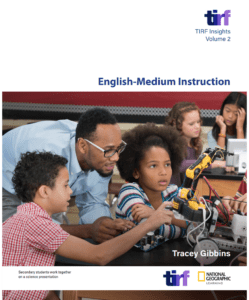New Ways to Support EMI Teachers, Students, and Schools
English-Medium Instruction (EMI) is the use of the English language to teach academic subjects in settings where English is not the most common language of education. Over the past two decades, the number of schools with EMI curricula has expanded dramatically because English is now essential for success in a variety of arenas, including politics, economics, technology, science, medicine, and media.
Context: EMI is experiencing growth in public sectors globally and is no longer limited to students at elite private academies and universities. However, research shows that issues persist in effectively implementing EMI in schools across all levels due to the complex nature of studying academic curriculum in a second or third language.
 What the Research Says: A growing number of EMI programs encourage teachers to take advantage of students’ first language (L1) to deliver new skills and content in English. In this way, two languages are used to process content and support students in becoming fully bilingual and academically successful.
What the Research Says: A growing number of EMI programs encourage teachers to take advantage of students’ first language (L1) to deliver new skills and content in English. In this way, two languages are used to process content and support students in becoming fully bilingual and academically successful.
Why it Matters: English is already the leading language of technology and medicine and is the business lingua franca. Young people are required to obtain a level of English proficiency not needed for previous generations. EMI can be foundational in the development of English language skills across the many disciplines required in modern education. Students with greater English proficiency have more university choices and greater career flexibility.
What’s Next: Globalization and EMI are interlinked: International students continue to look for programs providing EMI while English-medium institutions seek these students as a source of income and prestige. EMI will also continue to expand in primary and secondary sectors, in both private and public contexts. Research shows that students who begin an EMI program early in their education are often more successful throughout their learning in English-medium schools.
Read the Report: In this recent report from TIRF and National Geographic Learning, author Tracey Gibbins sets the backdrop of EMI in today’s educational arena and shares where this approach to language education is heading. This paper is available in multiple languages. Use the following links to download the version of the paper you wish to read:
About the “TIRF Insights” Series: The “TIRF Insights” series profiles recent research in the field of English Language Teaching (ELT) in a practical and accessible format. Our publication is written for parents, teachers, school leaders, and all student advocates who want to review recent educational trends in a nonacademic way.
Click here to download the English version of TIRF Insights: English-Medium Instruction.
Calls to Action: Here is a set of discussion questions that will help you and your team take next steps toward adopting, implementing, and/or furthering EMI at your institution:
- What are some of the challenges learners face in EMI classrooms? Is there a discrepancy in English language proficiency levels among students in classrooms in our community? Are the materials used with our students suitable for all levels of English proficiency?
- Which cultural backgrounds are reflected in our school or community’s student body? How does this cultural mix play a role in our school or community’s EMI approach? How do we currently include and support all students? What more can we do?
- How can educators support one another during EMI adoption? Which teachers feel challenged, and by which issues? How can administrators support these differing needs?
- We know there is often a performance gap in EMI classes between students with lower levels of English proficiency and those with greater proficiency. How can educators support both types of students to decrease the gap and provide appropriate academic instruction?
- Are there additional equity and inclusion issues present in the classroom? How can these be identified and addressed?

